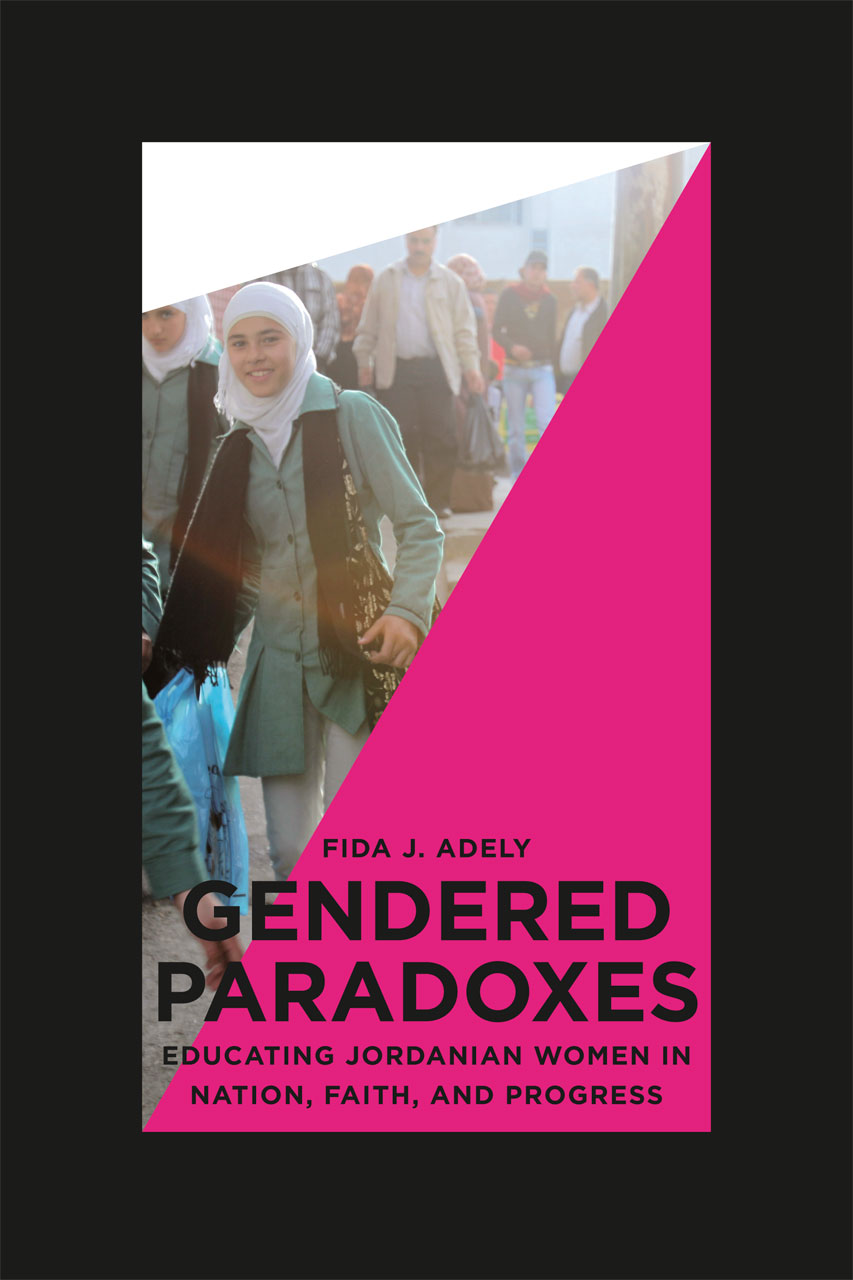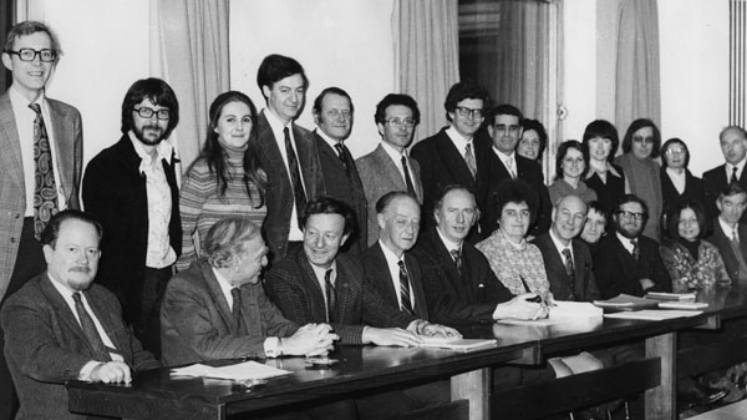
In 2005 the World Bank released a gender assessment of the nation of Jordan, a country that like many in the Middle East has undergone dramatic social and gender transformations, in part by encouraging equal access to education for men and women. The resulting demographic picture there—highly educated women who still largely stay at home as mothers and caregivers— prompted the World Bank to label Jordan a “gender paradox.” Cheryl Brumley is impressed by the way this book challenges development truisms and hopes the policymakers and development professionals take heed before enacting broad policies in the Middle East.

Gendered Paradoxes: Educating Jordanian Women in Nation, Faith, and Progress. Fida J. Adely. University of Chicago Press. 2012.
In an episode of the popular Jordanian sketch comedy Bath Bayakha (Broadcasting Silliness), an actor opens a skit outside a centre which trains Jordanians how to become Khalijin (Gulf Arabs). Inside he teaches participants about the Saudi currency, and takes jabs at the Gulf accent.They also dance spiritedly with gold-plated guns, a knock at the perceived excess of Khaliji life.
Two men then deliver animated testimonials about the benefits of the programme, “I used to be a Jordanian now I’m a Khaliji – very good” one says with two thumbs up. As the montage reaches its end, a woman in a niqab appears. It is assumed at this point she will give an equally enthusiastic testimonial. Instead, she blinks and stares as crickets faintly croak in the background. This is the climax of the skit, aside from the obvious swipes at the Gulf’s most distinctive stereotypes, it all builds up to the silence of the women in the niqab.
Why does this joke find resonance? A niqab is a rarity in Jordanian middle class life. Furthermore, Jordanian women are not restricted from driving, walking without a man, and their behaviour isn’t enforced formally by religious police as in the case of Saudi Arabia. We may not have the wealth of our southerly neighbours, it seems to say, but at least women in our country aren’t invisible.
In the area of education, Jordan is very progressive. Young Jordanian women have equivalent enrolment rates to men (p.141). Great strides were made to spread education across the entire country and across the gender divide, which picked up pace in the 1960s and 1970s. By 2008 Jordan had gross enrolment rates of 97% for girls and boys at the primary level and 90% at the secondary level (compared to 87% for boys) (p.37).
However, Jordan’s success with equal access to education has not been followed by lower birth rates and higher female workforce participation — the typical development narrative (p.11). In fact, the country remains far behind in these development indicators. The World Bank calls this Jordan’s “gender paradox” a phrase which Fida J. Adely, assistant professor at Georgetown University and Jordanian-American, has used for the title of her latest book. Despite the borrowed term, Adely doesn’t actually agree that there is anything paradoxical about this.
After spending eight months in an all girls secondary school in the provincial town of Bawadi al-Naseem, Adely develops an ethnographic portrait of young women under Jordan’s public education system. She offers a counter-narrative to the World Bank’s report, which she argues is blinded by stereotypes (p.12-13). The book’s narrowly framed title, though accurate, betrays its potentially expansive application across Middle Eastern, development and gender studies. Gendered Paradoxes‘s first chapter likewise distracts from the book’s overwhelmingly positive qualities. It begins with a story about the day in the life of a schoolgirl named Nada — but after the reader’s early investment in her life, it is revealed in the following chapter Nada is not a real person, just an amalgamation of young women Adely encountered in her study. I found with the amount of detail provided about the personal lives of students in the succeeding chapters, this narrative is unnecessary. Luckily, from here, the book gains strength.
Aside from the ethnographic explorations of how Islam and love for country are taught in schools, the book’s core message is that the young women in Bawadi al-Naseem were not simply swept away under the currents of patriarchy, which have prevented them from securing long-term employment after formal education. To the contrary, these girls were active participants in their future and responded to the challenges in their life in creative ways (p.164). They recognised education was important to their futures, but in Jordan education has taken on other meanings and became indicative of other successes. Education had merely been melded into pre-existing norms like marriagiability, class and respectability. The extent to which this influenced ideas around employment and birth rates was completely unanticipated by development organisations (and indeed, still not fully understood). “Not being educated or not doing well in school can now be considered a deficit and is often tied to implicit assumptions about a girl’s behavior and respectability. Such assertions are also clearly classed” (p.130). Education became a victim of its own ubiquity.
This idea, reinforced many times throughout the book, need not be taken lightly. Adely is questioning a universal development truism. “The logic of the World Bank can be turned on its head,” Adely states, “as people have appropriated the imperative of education for their own status concerns and needs, a reminder of the limits of the power of global development institutions” p.(134). In other words, education used as a “panacea” for female development neglects cultural twists. What’s more, Adely says that the over-reliance on the World Bank’s and UN’s quantitative data, and how they define employment, have also led researchers astray and have further failed to unearth the evolving realities in the country (p.141).
The ideas around gender are in flux in Jordan and women struggle with the new meanings placed around the education they receive. It is not, as another development report from the United Nations says, a problem of family patriarchy (p.161). This trivializes the very difficult choices women and their families have to make in an already limited employment sector. “Although parents did not express the language of gender equality or empowerment…they were concerned that their daughters have the power to care for themselves and their families” (p.160).
Adely writes with astonishing clarity. She delivers several striking blows to the reigning development narratives in subtle but damaging ways. She also rejects the common portrayal that women in the Middle East are “oppressed, weak and passive victims” (p.174). Her voice is neither angry, nor polemical, it is one of a very measured academic.
The book’s personal narratives and profiles on individual girls are very refreshing. It is this very complexity of adolescent life conveyed by Adely which builds a common undercurrent to the experiences of women the world over. Perhaps its greatest triumph is in showing how reports that lack qualitative evidence may end up enforcing development narratives that don’t ring true in every country; and so Adely plays her battle drum to the tune of nuance, nuance, nuance under a book title that may ultimately keep a wider audience at bay. If this is the case, it would be unfortunate because the book has so much to offer. As the ‘paradox’ of women’s opportunities in Jordan continues to play out, there is the risk that its causes, and inevitably its solutions, will rely on the same old stereotypes. Gendered Paradoxes can help policymakers and development professionals avoid this peril.
————————————————————————————
Cheryl Brumley is Digital Editor for the LSE Public Policy Group blogs and produces the LSE Review of Books Podcast. Cheryl joined the LSE PPG in January 2012 after graduating from the LSE with an MSc in Theory and History of International Relations with a focus on political Islam. Cheryl previously conducted research into social media and the Arab Spring at the Regional Centre for Conflict Prevention in Jordan, and researched for BBC World Service radio and Public Radio International. Read more reviews by Cheryl.







